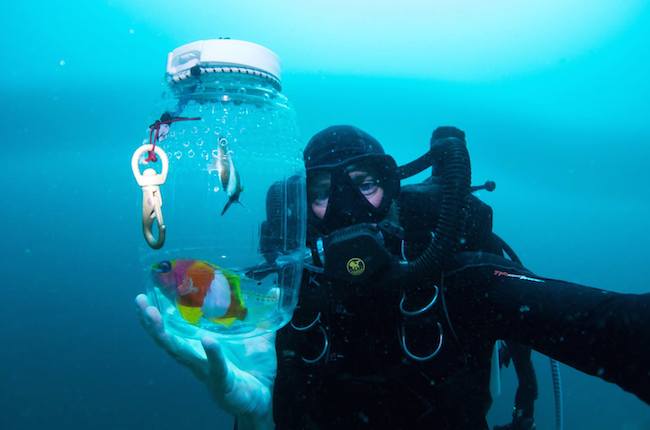After what has been a lengthy period of preparation, scouting and diving, the California Academy of Sciences’ expedition to the Philippines is beginning to yield a nice catch of truly exotic deep reef fish. The first notable catch of the expedition was Synchiropus circularis but now that the team has been pushing into the depths, some gorgeous deepwater oddballs are beginning to be brought to the surface.
Rich Pyle, Brian Greene, Bart Shepherd and Luiz Rocha have been using their deep diving skills to not only find and collect some rarely seen deep reef fish, but also using expert handling and decompression techniques to ensure the maximum chance that these fish will survive the ascent, and adapt to a new life hopefully on display at the Steinhart Aquarium.
Pictured above is Brian Greene holding two exquisite examples of fish that only come from deep reefs, Sacura speciosa and Roa excelsa, both of which are hardy fish provided that they are carefully handled and treated with care all along their journey to their future aquarium habitats.

In the wrasse department, two other species that have been brought up are Pseudojuloides mesostigma and Cirrhilabrus roseafascia. Both of these fish are exquisite species with Pseudojuloides mesostigma being closely related to the recently described Pseudojuloides edwardi and Cirrhilabrus roseafascia being able to grow to a large, showy size for a fairy wrasse.


In the lesser known fish category, the CAS dive team has brought up a rare Chromis degruyi and an undescribed species of Liopropoma. We love us some rare species of damselfish and despite looking silvery in the picture, when it settles into aquarium life the Chromis degruyi is likely to shine in its own unique way.
The undescribed Liopropoma specimen is a pink species with a yellow face and a yellow tail which will be described by Pyle, Greene and Rocha in the near future. While this particular species has been available to aquarists before, this is a fish that is notoriously plagued by decompression problems and it underscores the value of the CAS divers collecting and handling their own specimens.
It’s one thing to have a theoretical idea of where an aquarium fish came from, what habitat and environmental conditions it supposedly prefers and in some cases requires. But it’s a whole different experience for the aquarist and for the fish when the exact nature of its provenance and environment is known and we presume this is precisely some of the content that Dr. Luiz Rocha will delve on during his keynote presentation at MACNA 2014 – we can’t wait!



